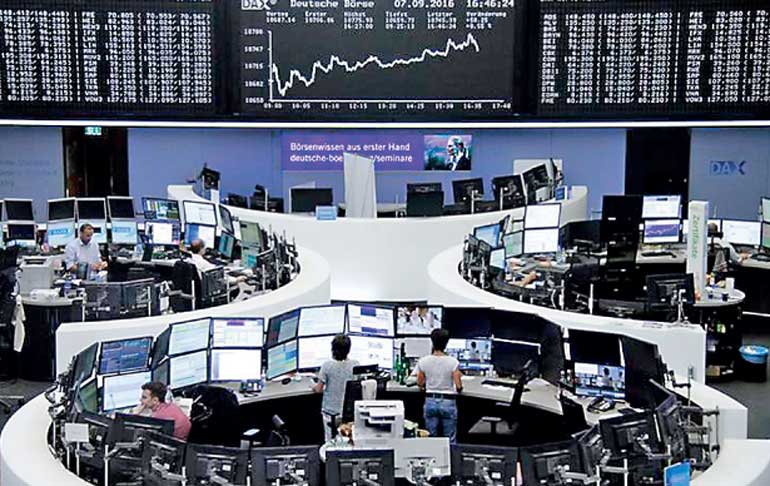Wednesday Feb 12, 2025
Wednesday Feb 12, 2025
Tuesday, 20 September 2016 00:03 - - {{hitsCtrl.values.hits}}
London (Reuters): Oil prices bounced back from multi-week lows on Monday, hauling up European stock markets and commodity-linked currencies, on hints that producers were close to reaching an output deal.
Crude prices rose more than 1%, with US futures bouncing off Friday’s one-month low to $43.65 and Brent climbing from a two-week trough to $46.27 after Venezuela said producers could announce a deal this month.
A firmer oil price bolstered energy company shares, helping European stocks climb after two straight weeks of losses. The pan-European 600 index, which had fallen to a six-week low on Friday, rose 0.7%, with the Europe 600 Oil & Gas index advancing 0.8%.
It also helped lift emerging market stocks around 1.5%, and commodity-linked currencies including the Canadian, Australian and New Zealand dollars, which were all around half a percent higher.
The US dollar was broadly weaker against a basket of other currencies, dipping 0.2% to 95.927, giving up some of Friday’s gains which were the biggest in a single day since late June.
 Traders work at their desks in front of the German share price index, DAX board, at the stock exchange in Frankfurt, Germany, 7 September
Traders work at their desks in front of the German share price index, DAX board, at the stock exchange in Frankfurt, Germany, 7 September
“It is not the first time this year we have had hopes of a deal and they have been dashed, but for now the oil rebound is supporting certain markets,” said Frederik Ducrozet, a senior economist at Pictet.
Earlier, MSCI’s broadest index of Asia-Pacific shares outside Japan gained 1.2% in a move that was largely attributed to bets that the US Federal Reserve would skip a chance to raise rates at a policy meeting this week.
Shanghai put on 0.5%, while Taiwan jumped 2.8% after a string of losses. Liquidity was lacking, with Tokyo closed for a holiday.
A surprisingly large rise in US consumer price inflation reported on Friday seemed to add to the case for a hike and pushed the dollar higher.
Yet most recent consumer and industrial activity data has disappointed, leaving the market still pricing in only a 12% probability of a rate rise this week, and 45% for December.
Assuming no move on policy, the focus will be on the FOMC’s forecasts for the funds rate, which this time extend to 2019.
“They may use the extension to lower their expectations for rates in 2017 and 2018, so that they end up with the same terminal level of rates, but just take longer to get there,” said Marshall Gittler, head of investment research at FXPRIMUS.
“In other words, a slower, more gradual pace of tightening. In that case, I would expect the dollar to weaken.”
There was little discernible market reaction to bombings in New York City and New Jersey and a stabbing at a Minnesota shopping mall.
While U.S. officials are investigating the attacks as potential “acts of terrorism,” they stopped short of characterising the motivation for any of them until more.
The Bank of Japan also meets this week and could well go in the opposite direction by easing policy, though conflicting reports on what it might do have stoked much uncertainty.
Sources have said the BoJ will consider making negative interest rates the centerpiece of future easing by shifting its prime policy target away from base money.
Any steps that markets consider to be less than aggressive would be likely to see the yen push higher and pressure the Nikkei.
Discover Kapruka, the leading online shopping platform in Sri Lanka, where you can conveniently send Gifts and Flowers to your loved ones for any event including Valentine ’s Day. Explore a wide range of popular Shopping Categories on Kapruka, including Toys, Groceries, Electronics, Birthday Cakes, Fruits, Chocolates, Flower Bouquets, Clothing, Watches, Lingerie, Gift Sets and Jewellery. Also if you’re interested in selling with Kapruka, Partner Central by Kapruka is the best solution to start with. Moreover, through Kapruka Global Shop, you can also enjoy the convenience of purchasing products from renowned platforms like Amazon and eBay and have them delivered to Sri Lanka.
Discover Kapruka, the leading online shopping platform in Sri Lanka, where you can conveniently send Gifts and Flowers to your loved ones for any event including Valentine ’s Day. Explore a wide range of popular Shopping Categories on Kapruka, including Toys, Groceries, Electronics, Birthday Cakes, Fruits, Chocolates, Flower Bouquets, Clothing, Watches, Lingerie, Gift Sets and Jewellery. Also if you’re interested in selling with Kapruka, Partner Central by Kapruka is the best solution to start with. Moreover, through Kapruka Global Shop, you can also enjoy the convenience of purchasing products from renowned platforms like Amazon and eBay and have them delivered to Sri Lanka.